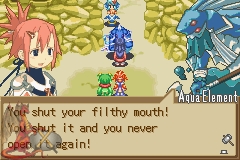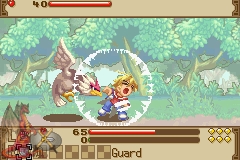|
|

|
BATTLE SYSTEM
|

|
INTERACTION
|

|
ORIGINALITY
|

|
STORY
|

|
MUSIC & SOUND
|

|
VISUALS
|

|
CHALLENGE
|
Frustrating
|
COMPLETION TIME
|
16-20 hours
|
|
OVERALL
2.5/5
|
Rating definitions
|
|
|
Summon Night: Swordcraft Story 2 is an interesting title. While ameliorating some of the irritations present in its predecessor, it introduces new ones. The game is very clearly the sequel to Summon Night: Swordcraft Story 1 Ė rarely is a sequel so obviously using its predecessorís elements. While probably worth playing for anyone with an interest in the titles, a love for Atlus translations, or a yen to dungeon crawl, it fails to impress in the most important ways.
If I were grading the quality of Atlusís translation Summon Night: Swordcraft Story 2 would receive a much higher mark. Witty lines are sprinkled throughout the text to make progressing much less arduous than it would be otherwise. What Atlus cannot do, however, is alter the basic story itself. The hero(ine) must reseal the summon creature Goura after that seal is ruptured. I played the hero Edgar, who distinguished himself by being one of the most naÔve main characters ever seen. At the beginning the main character acquires a Guardian Beast, which will aid in combat with spells and aids outside of battle by having a distinct personality. Aside from the banality of the plot, what distinguishes the game is a LOT of text. The potential player should prepare for frustration as characters chat to each other for a long time, saying things that even the best translation cannot make meaningful.
 Sad but true; our heroine needs to brush her teeth more often.
Sad but true; our heroine needs to brush her teeth more often.
|
|
Since a lot of time will be spent in battle, a rundown of it is in order. To any players of the first Swordcraft Story, the battles will be immediately familiar. They look remarkably like a fighting game. The main character will be on the field facing off with up to four enemies per battle, capable of guarding and jumping just like in a fighting game. Three weapons may be equipped and switched between using the L button in battle, while the R button moves along a little list of options. Having the Guardian Beast cast a magic spell is doable, although now items can be equipped to this options list also. There is a total of six actions that can be performed per battle Ė once all six have been used only guarding can be accomplished. Experience is gained after battle Ė the main characterís statistics increase and the Guardian Beastís Magic stat goes up along with possibly learning a new spell.
Battles are so similar to the first Swordcraft Story, in fact, that there arenít many differences. The same five weapon types are usable; the Guardian Beast plays the same role, etc. Spears are less effective now while axes are somewhat more effective. Knuckles provide a great agility boost but arenít powerful enough for some situations, drills work against a group fairly well, and swords are fairly balanced. But everything looks nearly identical to the first title and feels like it.
Outside of battle, things have changed. The crafting of weapons is no longer done by gathering materials and forging them. Instead Orbs will be found for each weapon, and by using the Orb along with a piece of forging material a weapon is made. The weapon can then be deconstructed to get the Orb back, although the forging material will be lost. Technique is gained not weapon by weapon, but accrues to each Orb. When a weapon is deconstructed to allow a new crafting to proceed, its current Technique rating halves. Technique dictates how effectively a weapon is wielded, and is increased by getting into battle and constantly using weapons.
 The Birds III: Mutation
The Birds III: Mutation
|
|
Environmental interaction no longer consists solely of a hammer. Each of the five weapon types has a use on the field, and all save the spearís are vital to progress (the spear is useful in obtaining certain items however). There is not one big dungeon with a few extras to progress through, but the game is still quite linear, making the paucity of warp points somewhat annoying. Shop menus are streamlined and simple, making the infrequent trips to the store easy enough.
Visually there is some improvement from the first Swordcraft Story, mostly in the use of more environments and quite a bit more color. In battle the weapons all look different and the spells have neat effects. The game is not among the GBAís top visual stars, but it more than suffices.
Aurally this title surpasses its predecessor. The sound quality is higher, and some of the music is worth listening to. Not all of it, but enough to make keeping the sound on a fair investment of time. There is a bit of voice acting in battle, and Atlus did a good job with it. Not stellar, but it more than suffices.
Challenge is of the annoying sort in Swordcraft Story 2. Regular enemies arenít too bad, as healing items are plentiful and provided the player doesnít play arrogantly the battles shouldnít be too dangerous. Bosses are a different matter. Bosses come in two types; the ones with easy-to-detect patterns, and the deadly. Central to the predicament here is the fact that bosses tend to be just fast enough to resume their attacking after a block has been performed by the player but before the player can safely throw out an attack. And blocking is frequently insufficient against boss attacks, which like to do worrying damage even with blocking. Let alone a few times when the player needs to confront two bosses at once Ė in a fighting game-style setup, this is painful. Bosses are also able to heal themselves multiple times during battle as the game goes on, leading to drawn-out fights that the player will find very difficult. Many bosses will require multiple tries to defeat, and their speed in battle will frustrate the player greatly.
The game isnít terribly long, but I probably spent at least 3 or 4 hours clicking through text again to fight bosses the second, third, or fourth time Ė and still losing. 20 hours seems a reasonable length for most people. Upon completion of the main plot, there is ample replay incentive; a new area opens (the first game did this too), other Guardian Beasts can be tried, and the other gendered character can be tried. The main plot doesnít seem to change much despite the gender of the lead, however. Also acquiring all the weapon crafting processes will take a fair amount of time.
To anyone interested in the title, it makes a fairly engrossing play. The crafting aspect prompts plenty of fighting to gain certain materials, and the aesthetics are respectable. The story is hardly deep but at least Atlus gave it some pizzazz. The challenge of certain bosses may be felt less by some others than it was by me, in which case a more favorable impression would probably be left. I cannot say that North America is crying out for the third Swordcraft Story to be localized after this gameís unparalleled success, however.
Review Archives
|









